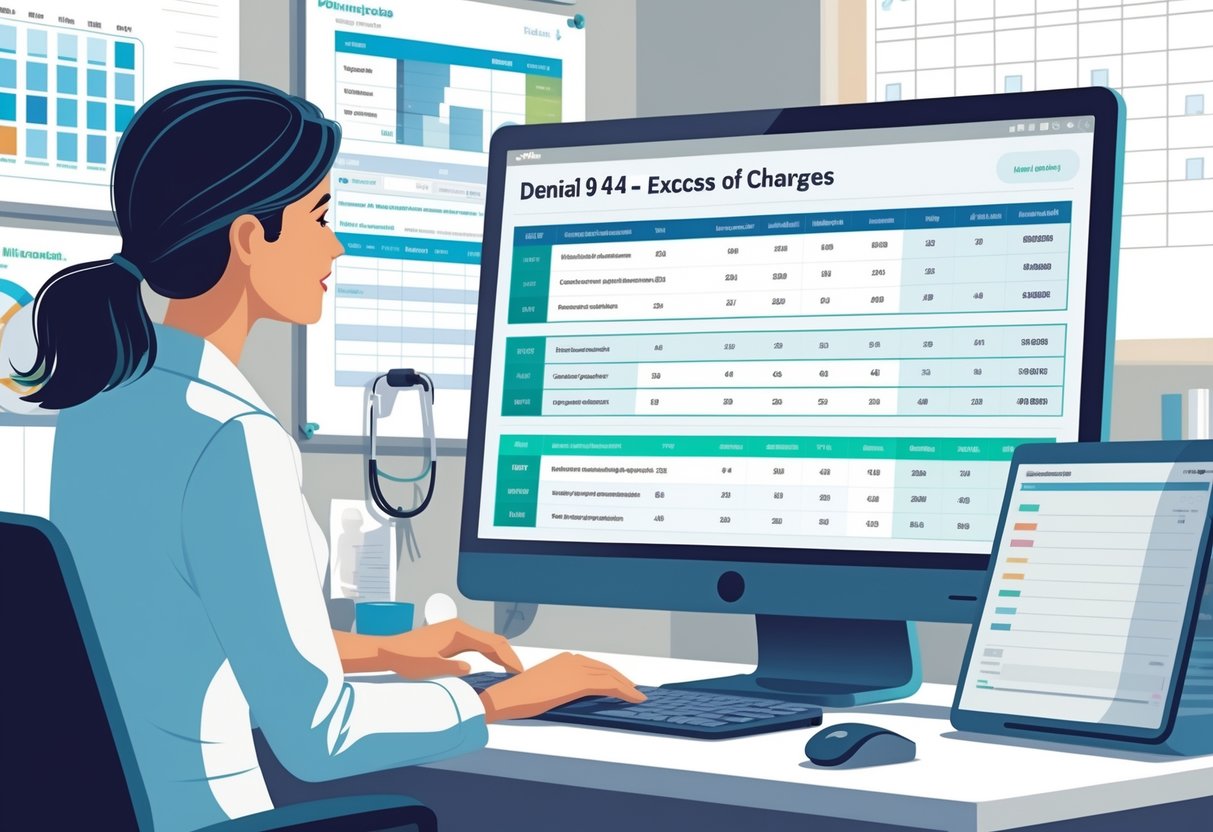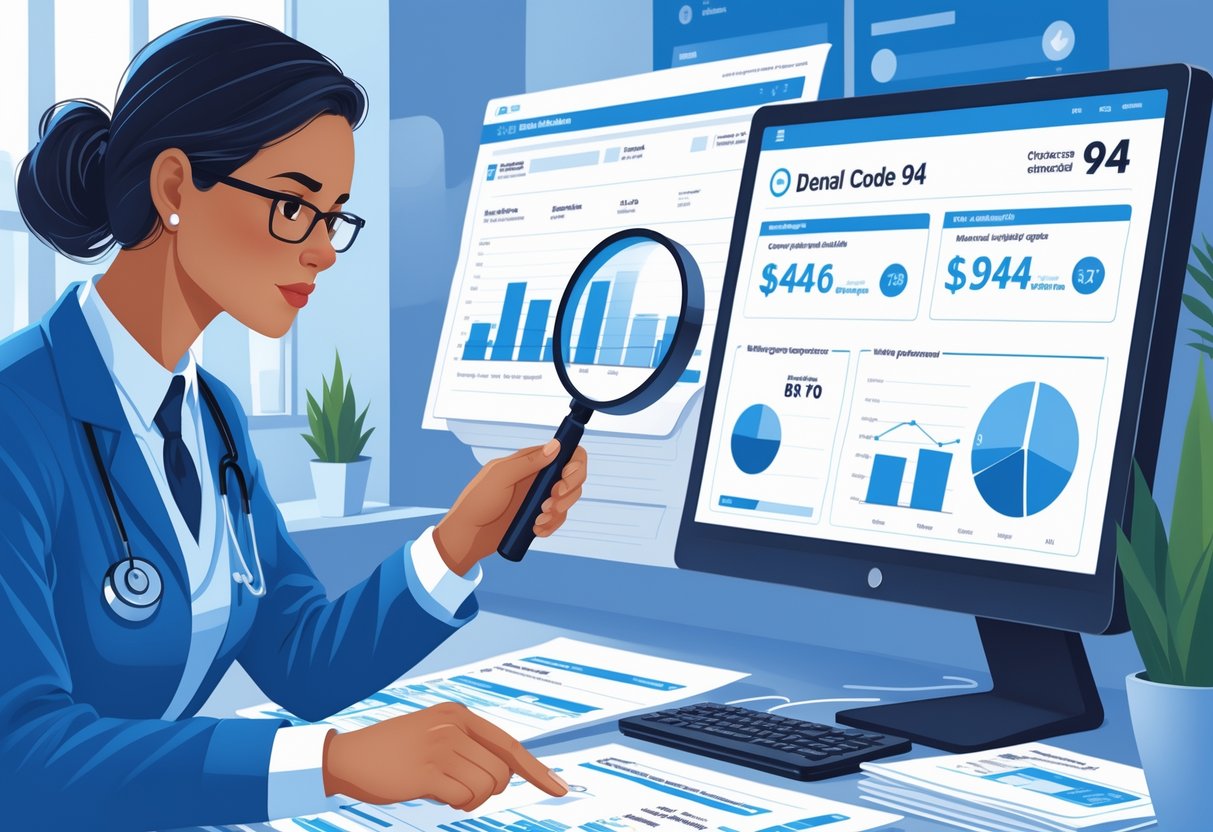Denial code 94 means your claim was processed for more than the allowed charge. This often happens when the billed amount exceeds the contracted or usual fee for a service. Understanding this code can help you avoid losing payments or delays in your reimbursements.
When you see denial code 94, it usually points to a billing issue where your charges don’t match what the payer allows. Knowing why this happens lets you fix the problem faster and get paid correctly.
If you want to prevent denial code 94, you need to check your charges carefully and compare them to your contract or fee schedule. This step can save you time and money on rejected claims.
Understanding Denial Code 94 – Processed in Excess of Charges

This denial code happens when a claim is paid for more than the amount billed or allowed. It often involves errors in billing or payment processing and requires careful review of the charges and payments.
Definition and Explanation
Denial Code 94 means the insurance company paid more than your billed charges or the allowed amount for a service. This can happen if the insurer applies the wrong fee schedule or if an overpayment occurs due to a system error.
When you see this code, it shows that adjustments may be needed because the payment exceeds what should have been paid based on your claims. The payer is signaling that part of the payment might need to be recovered or corrected.
This code helps protect payers from accidentally paying too much. You should check your billing details and the explanation of benefits (EOB) carefully to find any discrepancies.
Common Scenarios for Denial Code 94
You might receive this denial when:
- The paid amount is higher than the billed amount due to data entry errors.
- The insurer uses the wrong allowed charge or fee schedule.
- A previous payment was adjusted incorrectly, leading to an overpayment.
- Duplicate payments occur because the claim was processed twice.
This denial can also arise if you submit corrected claims after initial payments, but payments overlap or exceed total charges.
The key is to identify where the extra payment occurred and if you need to refund or adjust your claim.
Key Terminology
- Denied Amount: The portion of payment that exceeds what should have been paid.
- Allowed Charge: The maximum amount the payer approves for a service.
- Overpayment: When the insurer pays more than the billed or allowed charges.
- Explanation of Benefits (EOB): A document detailing how the claim was processed, payments made, and any denials.
Knowing these terms helps you understand the reason for the denial and what steps to take next. Always cross-check your claim details and EOB against these terms.
Causes of Denial Code 94 in Medical Billing

Denial code 94 happens when charges are higher than what the payer allows. This can occur due to mistakes in billing, submitting the same claim twice, or problems with how multiple insurances work together.
Billing Errors and Overcharges
You might see a denial code 94 if your claim has billing errors. This includes charging more than the allowed rate for a service or billing for services not covered by the contract.
Sometimes, clerical mistakes cause incorrect amounts to be entered. For example, entering the wrong procedure code or service date can make the claim look like it is overcharged.
Make sure your billing matches the payer’s fee schedule exactly. Double-check all codes and prices before submitting claims to avoid this denial.
Duplicate Claims Submission
Submitting the same claim more than once can trigger denial code 94. When a payer sees two claims for the same service, it might flag one as processed with excess charges.
This often happens if a claim is resubmitted due to delayed payments or after receiving an initial denial. You should verify if the claim was already processed before sending it again.
Keep records of all claims submitted and their status. This helps prevent duplicates and saves time in correcting denials.
Coordination of Benefits Issues
Denial code 94 can arise when you have multiple insurance plans involved. If primary and secondary payers do not coordinate correctly, it might look like you billed over the allowed amount.
For example, if the secondary insurance is billed without subtracting what the primary paid, you may get this denial.
You need to submit claims in the right order and provide accurate payment details from each insurer. This keeps billing in line with coordination of benefits rules.
Steps to Resolve Denial Code 94
You need to check your claim carefully to find why charges were processed beyond the allowed amount. Fixing billing errors and following proper resubmission rules will help you recover payments quickly.
Initial Claim Review Process
Start by reviewing the original claim details. Compare the billed charges to your contract or fee schedule to confirm if the charges are higher than allowed.
Look for duplicate charges, incorrect codes, or services not covered. Verify the patient’s eligibility and benefits at the time of service.
Document all findings clearly. If you find the problem is due to excess charges, you should correct these before submitting again.
Correcting Excess Charge Errors
Fix errors by adjusting the billed amount to match allowed fees. Remove any extra charges not supported by your contract or payer rules.
Use clear notes or attachments with your correction to explain changes. Avoid changing service codes unless you confirm they were incorrect.
Ensure your billing system reflects the new amounts before resubmitting. Keep copies of all corrected claims for your records.
Claim Resubmission Guidelines
Resubmit your corrected claim promptly to avoid delays. Use the original claim number and include a remark or code showing it is a corrected claim.
Follow the payer’s specific instructions on resubmission formats and deadlines. Proper resubmission helps the payer apply the payment adjustment correctly.
Track the status of your resubmitted claim until you receive confirmation or payment.
Prevention Strategies for Excess Charge Denials
You need clear methods to avoid denial code 94 related to excess charges. This includes accurate billing processes and continuous staff training to ensure everyone understands correct charge limits and documentation requirements.
Implementing Billing Best Practices
Start by reviewing your billing procedures regularly. Use software that flags charges exceeding allowed amounts before submitting claims.
Create a checklist for each claim to verify that charges match the payer’s fee schedule exactly. Check for duplicate charges or services billed multiple times.
Keep updated fee schedules on hand for all insurers you work with. This helps ensure your billing matches current guidelines and reduces the chance of excess charges.
Audit your claims monthly to catch and correct overcharges early. Consistent audits help identify patterns that lead to denials and allow you to fix issues fast.
Staff Training and Education
Train your billing staff on understanding payer rules and fee schedules in detail. Encourage questions and regular refresher sessions to keep knowledge current.
Use real denial case studies to show mistakes and teach corrective actions. This hands-on approach helps staff recognize common errors that lead to denial code 94.
Make sure your team knows how to document charges properly. Clear documentation supports charges and helps prevent disputes over excessive billing.
Regularly update training materials to include changes in payer policies and billing software features. This keeps your staff equipped to handle claims accurately.
Impact of Denial Code 94 on Revenue Cycle Management
Denial code 94 affects how much money you collect and how you track billing performance. It can lead to lost revenue and increase the need for careful monitoring of claims to avoid repeat errors.
Financial Implications for Healthcare Providers
Denial code 94 means a claim was processed with charges higher than allowed. This causes payments to be reduced or denied. You may lose significant revenue if many claims fall under this code.
You will need to review bills carefully to ensure charges match contract terms with insurers. Incorrect billing can delay payments and require costly resubmissions.
When claims are denied, your staff spends extra time fixing errors. This adds overhead costs and can slow your entire revenue cycle. Correcting these denials quickly is essential to maintain cash flow.
Performance Metrics and Denial Tracking
Tracking denial code 94 helps you identify billing errors early. Use denial rates and resolution times as key performance indicators (KPIs).
By analyzing patterns, you can spot common mistakes in billing or coding. This allows you to train staff and update processes to reduce future denials.
You should set clear goals for reducing denial rates and monitor your progress regularly. Automated systems can help by flagging potential overcharges before submission. This boosts efficiency and improves overall revenue health.
Frequently Asked Questions
You may need to take specific steps when dealing with denial code 94. Understanding what documents to provide, how to correct billing, and common reasons for this denial helps you address the issue effectively.
What steps can be taken to resolve a claim denial with code 94?
You should review the claim details carefully to identify where charges exceed allowed amounts. Then, contact the payer for clarification and verify the correct billing limits.
Which documentation is required when appealing a denial code 94?
You need to provide the original claim, corrected billing information, and any explanation of benefits. Also, include a detailed letter explaining why the charges are correct.
How does a provider correct a billing error that resulted in a denial code 94?
Check the charges against the payer’s fee schedule. Adjust the billed amounts to meet allowed limits, then resubmit the claim with corrected figures.
What are the common reasons for receiving a denial code 94 on a medical claim?
Charges that go over the agreed reimbursement rate cause this denial. It can also happen if duplicate billing or incorrect service codes are submitted.
How can providers avoid future denials related to denial code 94?
Verify payer fee schedules before billing. Use accurate coding and avoid charging more than allowed. Regularly audit your billing processes for errors.
Can a denial code 94 be disputed, and what is the time frame for doing so?
Yes, you can dispute it by submitting an appeal with proper documents. Most payers require appeals within 30 to 60 days from the denial date. Check specific payer policies for exact deadlines.








1 thought on “Denial Code CO 94 – Processed in Excess of Charges Explained and How to Resolve It”